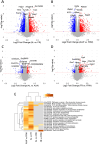Unraveling the brain expression of bdnf in a mouse model of anorexia nervosa
- PMID: 41107234
- PMCID: PMC12534498
- DOI: 10.1038/s41398-025-03618-7
Unraveling the brain expression of bdnf in a mouse model of anorexia nervosa
Abstract
Anorexia nervosa (AN) is a complex psychiatric disorder characterized by severe caloric restriction and distorted body image, leading to significant psychological and physiological complications. Brain-derived neurotrophic factor (BDNF) plays a critical role in cognitive function and metabolic regulation. A mutation in the BDNF gene is associated with anorexia nervosa. This study examines the effects of food restriction, refeeding and short-term refeeding on the expression of Bdnf and its receptor (tropomyosin receptor kinase B TrkB/Ntrk2) in key brain regions involved in reward and cognitive function. We assessed BDNF mRNA levels in the dorsal striatum (DS), nucleus accumbens, ventral tegmental area, and prefrontal cortex (PFC) of AN-like mice subjected to different feeding regimes combined with or without physical activity. Cognitive flexibility was assessed using the Y-maze test. Whole RNA sequencing was also performed to analyse gene expression changes. Food restriction induced a transient decrease in cognitive flexibility and significantly decreased Bdnf expression in the DS and PFC. Progressive refeeding restored Bdnf in the DS but not the PFC. Short refeeding restored Bdnf levels to baseline. TrkB expression is increased by restriction only in the PFC. The presence of a running wheel cancelled these effects, suggesting an interaction between physical activity and diet. Pathway analysis of dysregulated genes revealed enrichment in immune regulation and cell-cell communication pathways. These findings highlight the complex relationship between diet, exercise, and brain function in AN-like mouse model and suggest avenues for further research into the clinical relevance of BDNF and TrkB as biomarkers of eating disorders.
© 2025. The Author(s).
Conflict of interest statement
Competing interests: PG received during the last 5 years fees for presentations at congresses or participation in scientific boards from Biogen, Janssen, Lundbeck, Merk, Otsuka, Richter and Viatris. The remaining authors declare no competing interests.
Figures




References
-
- Mainz V, Schulte-Rüther M, Fink GR, Herpertz-Dahlmann B, Konrad K. Structural brain abnormalities in adolescent anorexia nervosa before and after weight recovery and associated hormonal changes. Psychosom Med. 2012;74:574–82. - PubMed
-
- Rosen E, Bakshi N, Watters A, Rosen HR, Mehler PS. Hepatic complications of anorexia nervosa. Dig Dis Sci. 2017;62:2977–81. - PubMed
-
- Duriez P, Ramoz N, Gorwood P, Viltart O, Tolle V. A metabolic perspective on reward abnormalities in anorexia nervosa. Trends Endocrinol Metab. 2019;30:915–28. - PubMed
MeSH terms
Substances
LinkOut - more resources
Full Text Sources
Miscellaneous

